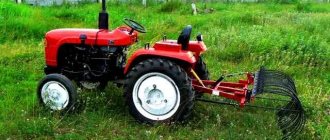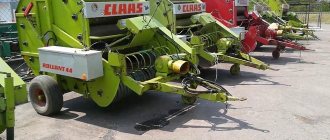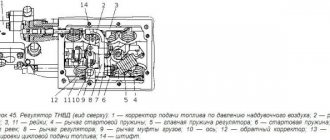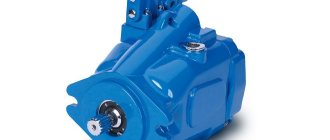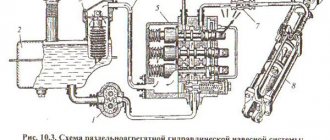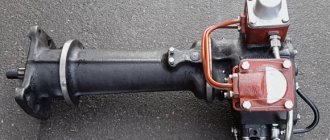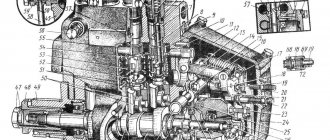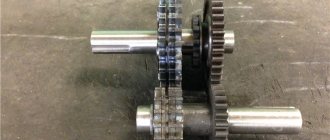Bales are formed and tied in the bale chamber. The main elements involved in this process are shown in the image below.
The bale chamber of the baler, rectangular in cross-section and tapering towards the exit, is located horizontally. Inside the chamber, a piston moves back and forth , driven by the connecting rod of the crank mechanism.
Pressing chamber with knitting machine: 1 - pressing chamber; 2 - piston; 3 — connecting rod; 4 - cassettes; 5 - wire or twine; 6 - needle; 7 — density regulator; 8 - measuring wheel; 9 - finger; 10 — power lever; 11 - dog; 12 - coupling; 13 - shaft; 14 — knife-clamp; 15 - crochet hook; 16 — wire guide; 17 - groove former.
, a knitting machine is installed on the bale chamber . It includes:
- two cassettes with wire or twine
- two needles
- measuring wheel
- clutch for turning on the knitting machine drive
- two knife clips
- two crochet hooks
- wire guide.
How does it work
The principle of operation of a square baler is that a special mechanism forms bales of geometric shape and wraps them with twine. This device can be used in small farms, as it has low productivity.
Device Features:
- You can adjust the bale density and size from the cab.
- Can work with Belarus tractors.
- The bales are lightweight, which allows them to be unloaded manually.
- Rectangular bales take up less space during transportation and storage.
- The unit operates on a flat surface.
Main elements of a round baler:
- A mini-press is a pressing device that consists of a housing, a box, a table for tying formed bales, hydraulic and electrical equipment.
- The gearbox transmits torque to the piston, which creates the press force.
- The table has a bale counter and a bale length adjustment mechanism.
- A pick-up is needed to collect hay. It has grippers that move the hay into the press area.
- The wheels are mounted on durable pipes.
- The piston compresses the hay.
- The stopper protects the piston from damage.
- The hydraulic system consists of cylinders, pipelines and hoses.
- Electrical equipment includes wires, lights, and sound signals.
During operation, the straw windrows should be to the right of the machine. The teeth pick up the straw and feed it into the bale chamber. The piston forms the bales. The density and size of the bale can be adjusted from the cab.
Baler - operating principle and purpose
Balers are used in the agricultural sector to collect swaths of dried grass for subsequent pressing. The bale or roll is then wrapped with binding material and pushed out onto the dump chute. The use of these machines can significantly improve the quality of straw and hay, and the amount of heavy manual labor is also significantly reduced. The moisture content of the hay should not be more than 25%. At the same time, bales and rolls can continue to dry in the barn. Depending on the method of forming the straw or hay mass, balers are divided into two families: round and square.
1. Square balers
— Basic structure and features of use.
This type of agricultural machinery, depending on the modification, can be used both in large farms and in small farms. The savings are especially noticeable when using them, because, unlike manual harvesting with a fork, there are no losses on the field or during transportation. Experience shows that any baler can be equipped with additional equipment, after which its capabilities can be significantly expanded.
Each manufacturer has a system for wrapping bales. Thanks to new materials and knitting methods, balers become more economical every year. The bales are compacted evenly so that each package has a standardized weight and dimensions, provided that the hay consists of only one crop of plants. With such pressing, the products do not lose their beneficial qualities.
Some baler models also allow you to bundle bales, which greatly speeds up loading/unloading at the destination. The pick-up collects hay almost completely thanks to curved teeth mounted on special shafts. Even the square picker has a round unit similar to the one found in round balers. The hay flow, captured by the teeth, is directed under the pressure rollers, the height of which above the tray allows you to change the thickness of the layer rolled into a bale. The pressing and gripping element can be based not only on rollers; there are also versions on a belt conveyor and on a plate conveyor. There are no significant differences in packing density or quality of hay mass molding, there is only a difference in service. All structures are approximately equal in complexity and cost of repair.
The capture is usually carried out over a width of 2-2.5 meters. This limitation is due to the fact that the windrows are usually no more than 1 meter wide, but there may be a lot of scattered hay around, which is also picked up. The collection width is also limited due to the tractor driver’s field of view. Periodically it is necessary to monitor the condition of the machine, which is very convenient to do with the help of a rear view camera installed on top of the cab.
The chamber where the bale is formed can be of constant or variable size. After the bale is stuffed (control is done by weight), a special device ties it. Typically, the speed of movement across the field ranges from 10-15 km/h. There are also particularly fast balers that are used for urgent field harvesting. Their operating speed can reach 40 km/h. You can increase the speed of any baler by installing a tandem axle with springs on it.
Each such unit has a special compartment into which coils or spools with binding material are loaded. This could be twine, nylon rope or even soft wire. The tension is provided by a special tensioning apparatus, and the tying is performed and the knots are tied by a knitting apparatus.
Technical features of the functioning of square balers.
Compaction in bale modifications occurs through a reciprocating motion. Simply put, it rolls layers in the same way we roll paper into a ball with our palms. The length, width and height of the bales are adjusted by pressing walls in a special chamber. It can be either constant size or changeable. Synthetic twine is usually used for tying. All control of the bale size and its density can be carried out both from the cabin and using a special remote control, which is located on the side of the unit.
Speed and trajectory are controlled directly by the tractor driver while driving using a hydraulic control lever. All pick-up mechanisms are driven by a rigid belt drive that operates without lubrication.
Sticks, garbage thrown out by people, and scrap metal are often found on the field. Therefore, each of these machines is equipped with specialized protection against foreign objects getting into the hay mass. Either an emergency reset or a partial reset can operate. In case of jamming, the pulleys with working belts are brought closer to each other so that the belt slips and does not transmit force. There is another protective mechanism, which is based on a protective overrunning clutch. It stands between the cardan and the flywheel, transmitting force between them. If something rigidly blocks the operation of the pick-up, then the clutch disengages, and the flywheel is instantly stopped by the friction brake shoe. Some baler models have a special container that can collect any debris other than hay or straw. This guarantees exceptional product quality.
All balers have hopper overfill protection, which is activated by a special strain gauge located in the upper wall of the baling chamber.
2. Round balers.
They are practically no different from square balers in terms of the principle of collecting hay or straw on the field. The main difference is in the bale chamber. The twine for tying rolls is always under tension using a tension device. As soon as a layer of compressed hay enters the chamber from the conveyor, it is picked up from the sides by two forks, which begin to twist the roll. The pressing chamber has the shape of a drum with guide ribs that allow the blades of grass to be laid more densely. Rotation is transmitted to the forks via a compression belt. As soon as the mass of the bale reaches a certain value, the flow of incoming hay stops, and the drum makes several dozen rapid revolutions to compact it using centrifugal force. At the last revolutions, twine is released from the spool, which wraps the hay in a spiral. The tying head makes strong knots, after which the bale is pushed out by a piston onto the field or onto a special trailer.
Conclusion.
Often, beginning farmers do not know which baler is better to choose – a round or square baler. It all depends on the tasks assigned. The only way to compact hay in a truck or carriage as much as possible is in bales. But rolls can be easily rolled onto platforms using manual force or using machinery. The roll dimensions can be very large, so it will be possible to clear the field much faster. Bales are more conveniently stacked in stacks and stacks, but rolls have to be stored standing up so that moisture circulates well in them. You can also say for sure that rolls are more suitable for large farms, and bales are more suitable for small farms.
Advantages and disadvantages
Advantages:
- saving time on agricultural work;
- reduction in product costs;
- energy saving;
- reduction of losses;
- It is convenient to store hay.
Flaws:
- Inexpensive Soviet-era models are no longer produced, and therefore there are no spare parts for them.
- When using such models, repair difficulties arise.
- Homemade structures break down quickly and do not always meet standards.
- Modern Russian-made devices are inferior in quality to foreign ones.
- Foreign models are expensive, and their maintenance does not pay off.
What to choose
The following types are currently produced:
- square baler;
- baling machine.
The bale machine is equipped with a device for receiving hay, a pressing and knitting mechanism, and an adjustment device. The baling process is carried out as follows: the teeth pick up the windrow and transport it using an auger to the bale chamber. When the feed pressure reaches the limit, the tying machine is turned on, and after tying, the bale is thrown to the ground.
When choosing square pickers, pay attention to the following characteristics:
- the ability to adjust the bale density and size;
- the ability to work on an area with an uneven surface;
- mechanism power;
- working width;
- throughput;
- speed of work;
- reliability of design;
- ease of maintenance and repair.
The main choice is made depending on the performance of the equipment. A unit that is too powerful will take a long time to pay for itself and remain idle; a weak one will not be able to process the required area in a short time.
German models
The German Welger bale picker is used for baling hay and straw. The design works in conjunction with a low-power tractor of only 35 hp. The productivity of the unit is 7 t/hour. Straw pressing is carried out in a working chamber, which has dimensions of 36x48 cm. The adjustment system makes it possible to choose the length of a hay bale from 30 to 130 cm. The prices for such models are quite high.
Polish models
The Polish model of the Simpa pick-up has been produced for over 30 years. The quality of work of this unit is high. The Simpa RK4000 model is equipped with a hydraulic system for lifting straw from the ground. The design allows for the installation of skids for transporting finished bales to a trailer.
Specifications:
- Dimensions of the press: 4.85 x 2.5 x 1.6 m.
- Weight 1.6 t.
- The dimensions of the working chamber are 40x60 cm.
- Bale length 30-135 cm.
- Capacity 25 t/hour.
Model overview
Please note that roll-type equipment is found on farms much more often than its bale counterparts.
This is because square balers require more maintenance and are more expensive. Therefore, we will consider two roll modifications that are in great demand among farmers.
PRF 145
This modification has virtually no design flaws and has a high safety margin. The technical indicators of this equipment look like this.
| Structural mass | 1,900 kg. |
| Dimensions: length/width/height | 4 150/2 300/2 400 mm. |
| Covered area | 1.45 m. |
| Roll diameter | 145 cm. |
| Bale weight: hay/straw | 375/250 kg. |
| Speed indicators | 6-12 km/h. |
| Performance | 5.5 tons/hour. |
PRF 180
This is a round baler with a closed working chamber. This design of the equipment allows us to minimize plant mass loss and forms rolls with a dense top layer and a loose middle.
As a result, air freely penetrates inside the roll, preventing the formation of mold. The unit is based on a pressing mechanism, which is made in the form of a chain conveyor that continuously twists and compacts the plant mass.
The weight of the trailed equipment is 2,400 kilograms, which allows the baler to be mounted with tractors of 1.4-2 traction class.
